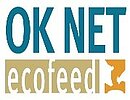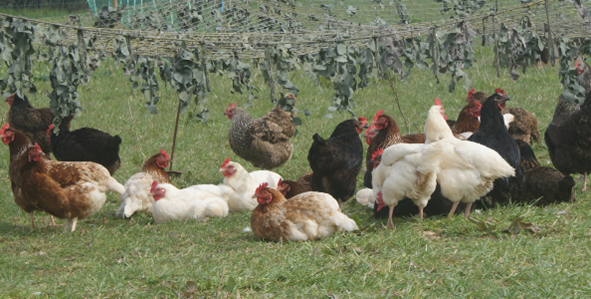Feeding strategies for broiler chickens
Problem
Organic broilers grow slower than conventional birds and so producers face the challenge of feeding quality feed components at lower concentrations. Feed needs to fulfil the amino acid and energy requirements of broilers for efficient growth and development, but growth is slower.
Solution
Choice feeding, access to range and forages can increase the utilisation of protein and energy, which will increase feed efficiency. The requirements for birds to use the range area is part of the solution.
Benefits
Improved energy and protein utilisation in broilers. Furthermore, as these approaches rely on local feed sources and forage from the range, the feeding strategies add to agricultural sustainability and reduce the need to import foreign feed.
Applicability box
Geographical coverage
In all countries
Application time
Any time
Required time
No extra time required
Period of impact
Immediate Impact
Equipment
Existing feed equipment
Best in
All conditions
Practical Recommendations
Organic standards require organic broilers to be free range and have access to open-air spaces as soon as possible (figure 1) but at a minimum ofone-third of their life. The minimum slaughter age for broilers is 81 days.
- Feed components should contain high-quality proteins, e.g., legumes, aquatic feed sources and by-products from food manufacturing and industrial processes.
- Organic standards prevent the use of synthetic amino acids, so there is a need to ensure amino acid availability (especially methionine and lysine).
- A phase feeding strategy should be used to account for the differences in the dietary needs of broilers during different growth stages.
- Account for feed consumed in outdoor areas (i.e., roughages) when calculating nutritional requirements and formulating feed rations.
- Formulate diets on a digestible amino acid basis rather than on a total amino acid or crude protein level.
- Choose appropriate breeds that are able to perform with the given resources, particularly slower-growing breeds.
Slower-growing breeds will need less energy-dense rations and are also more inclined to seek food in the range.
Choice feeding, where birds select separate foods, rather than manufactured compound feed, has been found to increase Feed conversion efficiency (FCE) when birds have access to range.
Limiting protein intake for organic broilers in the finishing stages can be an acceptable feeding strategy if the broilers have access to vegetation with a high nutritional value. Reducing protein levels for slow-growing breeds to 15% resulted in a lower FCE but a lower cost of production.
Key to this is range management and alternative forages, such as baled haylages, which will be needed during winter or drought periods. High protein sources such as lucerne and clovers can also supply some of the required protein. Account can also be taken of insects and invertebrates eaten on the range, which can supply some of the protein and amino acids required.
Further information
Reading
- Fanatico, A. C. et al. (2016): Choice feeding of protein concentrate and grain to organic meat chickens. Journal of Applied Poultry Research.
- Ramos Elorduy, J. et al. (2002): Use of Tenebrio molitor (Coleoptera: Tenebrionidae) to Recycle Organic Wastes and as Feed for Broiler Chickens. Journal of Economic Entomology.
- Lampkin, N. et al. (Ed.) (1997): Constraints on developing organic poultry production OF0128T. University of Wales, Aberystwyth, Welsh Institute of Rural Sciences.
- Bassler, A. and Ciszuk, P. (2002): Pilot studies in organic broiler production – management and cross-breeds. Ekologiskt lantbruk, no. 34. Centre for Sustainable Agriculture.
- Adedeji, O. et al. (2013): Effect of Different Organic Feed Ingredients on Growth Performance, Haematological Characteristics and Serum Parameters of Broiler Chickens. World Journal of Agricultural Sciences.
- Further information can be found on the Organic Farm Knowledge platform.
About this practice abstract and OK-Net EcoFeed
Publishers:Soil Association, Spear House,
UKBS1 6ADBristol,
Phone ,
,
www.soilassociation.orgResearch Institute of Organic Agriculture (FiBL),
CH5070Frick,
Phone +41 62 865 72 72,
info.suisse@fibl.org,
www.fibl.orgIFOAM Organics Europe,
BE1000Brussels,
Phone +32 2 280 12 23,
www.organicseurope.bio,
www.organicseurope.bio
Review: Lindsay Whistance, ORC, UK
Contact: jalford@soilassociation.org
Permalink: https://organic-farmknowledge.org/tool/37940
https://orgprints.org/view/projects/OKNetEcoFeed.html
This practice abstract was elaborated in the Organic Knowledge Network on Monogastric Animal Feed project. The project is running from January 2018 to December 2020. The overall aim of OKNet EcoFeed is to help farmers, breeders and the organic feed processing industry in achieving the goal of 100% use of organic and regional feed for monogastrics.
Project website: https://ok-net-ecofeed.eu/
IFOAM Organics Europe (project coordinator), BE; Aarhus University (ICROFS), DK; Organic Research Centre (ORC), UK; Institut Technique de l'Agriculture Biologique (ITAB), FR; Research Institute of Organic Agriculture (FiBL), CH; Bioland, DE; Associazione Italiana perl'Agricoltura Biologica (AIAB), IT; Donau Soja DS, AT; Swedish University of Agricultural Sciences, SE; ECOVALIA, ES; Soil Association, UK.



This project has received funding from the European Union’s Horizon 2020 research and innovation programme under grant agreement No 773911. This communication only reflects the author’s view. The Research Executive Agency is not responsible for any use that may be made of the information provided. The authors and editors do not assume responsibility or liability for any possible factual inaccuracies or damage resulting from the application of the recommendations in this practice abstract
